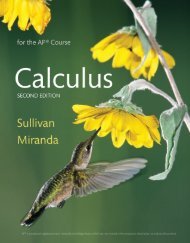SPA 3e_ Teachers Edition _ Ch 6
You also want an ePaper? Increase the reach of your titles
YUMPU automatically turns print PDFs into web optimized ePapers that Google loves.
Answers continued<br />
X<br />
18. (c) p^ =<br />
n , so X = p^ n; (0.33)(1500) =<br />
495 and (0.37)(1500) = 555<br />
495 − 525<br />
(d) z = = −1.62;<br />
18.47<br />
555 − 525<br />
z = = 1.62<br />
18.47<br />
P(495 # X # 555)= P(−1.62 ≤ Z # 1.62)<br />
= 0.9474 − 0.0526 = 0.8948<br />
Using technology: Applet/normalcdf(lower:<br />
495, upper:555, mean:525, SD:18.47)<br />
5 0.8957. This answer matches the answer<br />
from the example that uses the sampling<br />
distribution of p^ , except for rounding.<br />
19. (a) Shape: Both distributions are<br />
skewed to the right. Center: Drivers<br />
generally take longer to leave when<br />
someone is waiting for the space. Spread:<br />
There is more variability for the drivers<br />
with someone waiting. Outliers: There<br />
were no outliers for those with someone<br />
waiting, but there were two high outliers<br />
for those with no one waiting.<br />
(b) Not necessarily; the researchers<br />
merely observed what was happening,<br />
and they did not randomly assign the<br />
treatments of either having a person<br />
waiting or not to the drivers of the cars<br />
leaving the lot.<br />
20. (a)<br />
Relative frequency<br />
1.05<br />
1<br />
0.95<br />
0.9<br />
0.85<br />
0.8<br />
0.75<br />
0.7<br />
0.65<br />
0.6<br />
0.55<br />
0.5<br />
0.45<br />
0.4<br />
0.35<br />
0.3<br />
0.25<br />
0.2<br />
0.15<br />
0.1<br />
0.05<br />
0<br />
Key<br />
Other<br />
Hazel<br />
Green<br />
Brown<br />
Blue<br />
432<br />
C H A P T E R 6 • Sampling Distributions<br />
(a) Write a few sentences comparing these distributions.<br />
(b) Can we conclude that a waiting car causes drivers to<br />
leave their spaces more slowly? Why or why not?<br />
20. Those baby blues (2.1, 4.4) The two-way table<br />
summarizes information about eye color and gender<br />
in a random sample of 200 high school students.<br />
Gender<br />
Male Female Total<br />
Blue 21 29 50<br />
Brown 35 40 75<br />
Eye color green 14 21 35<br />
Hazel 12 23 35<br />
Other 2 3 5<br />
Total 84 116 200<br />
(a) Is there an association between eye color and gender<br />
in this group of students? Support your answer<br />
with an appropriate graphical summary of the data.<br />
(b) Select a student at random. Are the events “Student<br />
is male” and “Student has blue eyes” independent?<br />
Justify your answer.<br />
Lesson 6.5<br />
The Sampling Distribution<br />
of a Sample Mean<br />
L e A r n i n g T A r g e T S<br />
d<br />
d<br />
Find the mean and standard deviation of the sampling distribution of a sample<br />
mean x and interpret the standard deviation.<br />
Use a normal distribution to calculate probabilities involving x when sampling<br />
from a normal population.<br />
When sample data are categorical, we often use the count or proportion of successes<br />
in the sample to make an inference about a population. When sample data are quantitative,<br />
we often use the sample mean x to estimate the mean m of a population. When<br />
we select random samples from a population, the value of x will vary from sample<br />
to sample. To understand how much x varies from m and what values of x are likely<br />
to happen by chance, we want to understand the sampling distribution of the sample<br />
mean x.<br />
Male<br />
Gender<br />
Female<br />
Yes, because the percentages for a<br />
given eye color are not the same for<br />
each gender. In other words, knowing<br />
a person’s gender helps us predict eye<br />
color. Males are more likely than females<br />
to have brown eyes, while females are<br />
more likely than males to have hazel or<br />
green eyes.<br />
(b) P(blue eyes | male) 5 21/84 5 0.25;<br />
P(blue eyes | female) 5 29/116 5 0.25.<br />
Because the probabilities are equal,<br />
the events “male” and “blue eyes” are<br />
independent. Knowing that a student<br />
is male does not change the probability<br />
that he has blue eyes.<br />
Starnes_<strong>3e</strong>_CH06_398-449_Final.indd 432<br />
Learning Target Key<br />
The problems in the test bank are<br />
keyed to the learning targets using<br />
these numbers:<br />
d 6.5.1<br />
d 6.5.2<br />
BELL RINGER<br />
Thinking back to the “A penny for your<br />
thoughts?” activity for samples of<br />
5 pennies, did every sample produce the<br />
same sample mean year? What is the<br />
name for this phenomenon?<br />
Teaching Tip<br />
Be picky with students about using the correct<br />
symbols! The sample mean is denoted x and<br />
the population mean is denoted m.<br />
Common Error<br />
This lesson and the next are about means, not<br />
proportions. Make sure students don’t use the<br />
symbols p and p^ when working with means.<br />
18/08/16 5:02 PMStarnes_<strong>3e</strong>_CH0<br />
432<br />
C H A P T E R 6 • Sampling Distributions<br />
Starnes_<strong>3e</strong>_ATE_CH06_398-449_v3.indd 432<br />
11/01/17 3:56 PM




